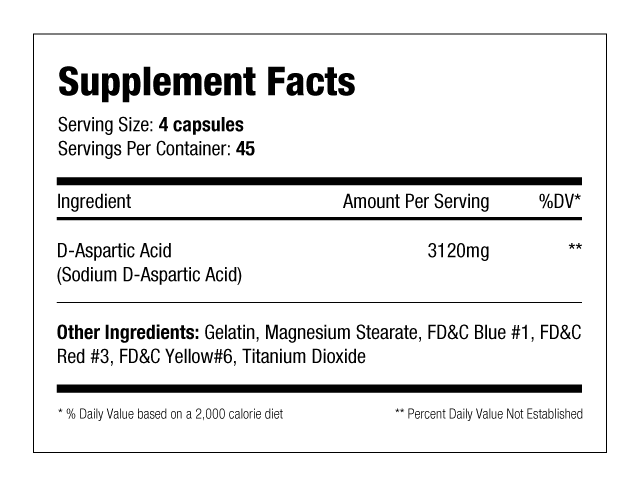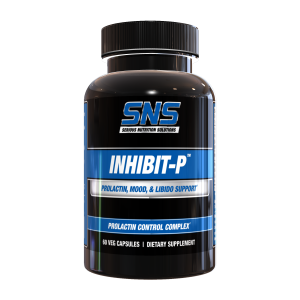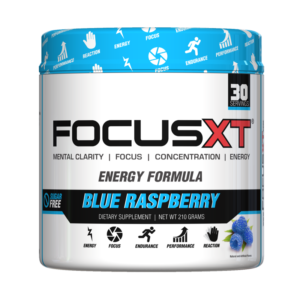Natural Testosterone Booster & Improved Libido Support*
SNS DAA capsules contains 3.12 grams (3,120 mg) of Sodium D-Aspartic Acid per serving.
D-Aspartic Acid is a physiological amino acid occurring principally in the pituitary gland, hypothalamus, and testes (1, 2, 3, 4). It is a very potent sexual stimulator (2, 4, 5), and can be used to help enhance libido (2), erection quality, duration of intercourse, and perceived orgasm intensity (5, 7). D-Aspartic Acid can also enhance Nitric Oxide levels, and can induce the elevation of neurotransmitters such as dopamine and GABA, which are thought to be responsible for memory enhancement, improved sense of well-being, and nootropic effects (4, 7).
SNS DAA Capsule Highlights:
- Contains Sodium D-Aspartic Acid (the type shown effective in human studies)
- Contains the dosage used in human studies (3.12 grams per day)
- Non-Steroidal/Prohormone free
- No Proprietary Blends
What the Research Says:
Research on Sodium D-Aspartic Acid has shown that it serves as a specialized neurotransmitter in parts of the nervous system involved in hormone production, and has been shown to stimulate the release of LH and GH from the pituitary gland (2, 4, 5, 6). It has also been shown to have a direct stimulating effect in the testes on testosterone production (2, 3).
A human study on D-Aspartic Acid showed that it raised testosterone levels in healthy adult males an average of 42% in as little as 12 days, with some experiencing a boost of over 50% in that same period of time. This study also indicated that testosterone levels were still elevated 3 days after the discontinuation of D-Aspartic Acid, which indicates that it builds up over time, and then slowly decreases after supplementation is stopped (7).
The above study shows for obvious reasons why Sodium D-Aspartic Acid is desirable for athletes and weights trainers looking to build lean muscle and strength.
It is important to note that the dosage used in the study was 3.12 grams per day, which is the exact dosage used in SNS DAA Caps.
Stacking & Synergy:
SNS DAA Capsules can be stacked with SNS Inhibit-P, Bulbine, Tribulus-750, or other select SNS products for improved synergistic results.
References
- D’ANIELLO, A., DI FIORE, M., FISHER, G., MILONE, A., SELENI, A., D’ANIELLO, S., PERNA, A. and INGROSSO, D. (2000). Occurrence of D-aspartic acid and N-methyl-D-aspartic acid in rat neuroendocrine tissues and their role in the modulation of luteinizing hormone and growth hormone release. The FASEB Journal, 14(5), pp.699-714.
- D’Aniello, A. (2007). d-Aspartic acid: An endogenous amino acid with an important neuroendocrine role. Brain Research Reviews, 53(2), pp.215-234.
- Topo, E., Soricelli, A., Di Maio, A., D’Aniello, E., Di Fiore, M. and D’Aniello, A. (2009). Evidence for the involvement of d-aspartic acid in learning and memory of rat. Amino Acids, 38(5), pp.1561-1569.
- D’Aniello, A., Cosmo, A., Cristo, C., Annunziato, L., Petrucelli, L. and Fisher, G. (1996). Involvement of D-Aspartic acid in the synthesis of testosterone in rat testes. Life Sciences, 59(2), pp.97-104.
- Dunlop, D., Neidle, A., McHale, D., Dunlop, D. and Lajtha, A. (1986). The presence of free D-aspartic acid in rodents and man. Biochemical and Biophysical Research Communications, 141(1), pp.27-32.
- Morari, M., O’Connor, W., Ungerstedt, U. and Fuxe, K. (1993). N-methyl-d-Aspartic Acid Differentially Regulates Extracellular Dopamine, GABA, and Glutamate Levels in the Dorsolateral Neostriatum of the Halothane-Anesthetized Rat: An In Vivo Microdialysis Study. Journal of Neurochemistry, 60(5), pp.1884-1893.
- Topo, E., Soricelli, A., D’Aniello, A., Ronsini, S. and D’Aniello, G. (2009). The role and molecular mechanism of D-aspartic acid in the release and synthesis of LH and testosterone in humans and rats. Reproductive Biology and Endocrinology, 7(1), p.120.
* These statements have not been evaluated by the Food and Drug Administration. This product is not intended to diagnose, treat, cure, or prevent any disease.







Reviews
There are no reviews yet.